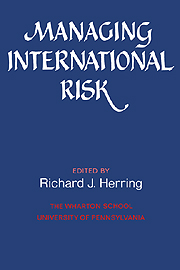 Managing International Risk
Managing International Risk Published online by Cambridge University Press: 07 May 2010
To be sustained, capital flows must move funds from those with a high marginal propensity to save to investors with high marginal returns on capital. This is obviously the underlying rationale of current capital flows from capital-rich, high-income countries to low-income, capital-poor, developing countries.
International capital flows are as old as nations. Some lending across national borders has always had higher risk elements than some domestic lending: For some of the lenders and intermediaries involved, such risks made lending very profitable, but others, of course, suffered losses.
It was widely argued when the flow of commercial capital to developing countries began again after World War II that investing in developing countries was very risky. The developing countries' outlook was very uncertain, many were ideologically opposed to private foreign capital inflows, and it was feared that political instability would diminish rather than expand further investment opportunities. Expropriation (the nationalization of direct investment without compensation) and repudiation (the cancellation of debt) were feared. A broad network of public insurance and guarantees therefore began to be laid down by both the industrial and developing countries to stimulate capital flows.
More than thirty years later it is not at all clear that lending to developing countries is, on the whole, unduly risky, or that it is riskier than lending to other countries or than domestic lending. It is also not clear that “managing” risks entailed in international capital flows reduces the costs of borrowing and increases the profits of lending.
To save this book to your Kindle, first ensure [email protected] is added to your Approved Personal Document E-mail List under your Personal Document Settings on the Manage Your Content and Devices page of your Amazon account. Then enter the ‘name’ part of your Kindle email address below. Find out more about saving to your Kindle.
Note you can select to save to either the @free.kindle.com or @kindle.com variations. ‘@free.kindle.com’ emails are free but can only be saved to your device when it is connected to wi-fi. ‘@kindle.com’ emails can be delivered even when you are not connected to wi-fi, but note that service fees apply.
Find out more about the Kindle Personal Document Service.
To save content items to your account, please confirm that you agree to abide by our usage policies. If this is the first time you use this feature, you will be asked to authorise Cambridge Core to connect with your account. Find out more about saving content to Dropbox.
To save content items to your account, please confirm that you agree to abide by our usage policies. If this is the first time you use this feature, you will be asked to authorise Cambridge Core to connect with your account. Find out more about saving content to Google Drive.